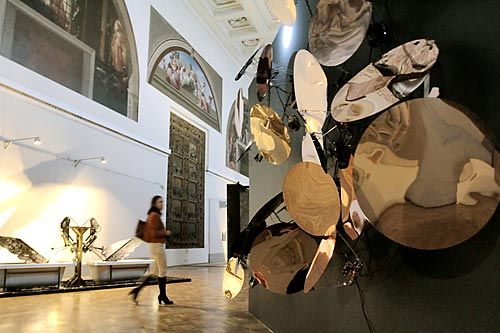The “Cyberfest” is marking its tenth anniversary with special grandeur, showcasing an international festival of art that utilizes new technologies. The event features exhibitions at eight prestigious venues with the participation of 80 artists, retrospectives of video programs from previous years, a mini-festival of sound art (audio art), and an educational program.

However, the essence of the event remains unchanged. It’s encapsulated in the artists’ attempt to answer the “cursed questions.” Why fill artworks with computers and complex programs that ensure interactivity? Why, in the context of severely limited budgets, construct towers and fortresses out of displays where reality is simulated?
From an external perspective, the situation looks like a losing battle. Electronic gimmicks are quickly mastered by clubs, shopping and entertainment centers, and other agents of consumer society. They have incomparably greater financial capabilities than artists.
Meanwhile, science art, which synthesizes science and art – whether growing new stem cells, creating bio-computers, etc. – presupposes a leading role for scientists. Artists are merely followers in the process of seeking new knowledge. They often raise important questions about the social and ethical responsibilities of researchers, but that is a separate topic.
Anna Frants, the founder of “Cyberfest,” named the festival “Coordinate System,” recalling a historical anecdote about the philosopher and mathematician René Descartes. Once, the scientist spent an entire day in bed, pondering something. He was constantly disturbed by a buzzing fly. He then began to think about how to describe the insect’s position in space to kill it without missing. As a result, the rectangular coordinate system was born.
Similarly, artists participating in the festival are trying to determine their position in contemporary society, which is under the strong influence of mass media and social networks.
The two main exhibitions of “Cyberfest-10” – “Interpretations” (curated by Elena Gubanova) at the Museum of the Academy of Arts and “The Effect of Presence” (curated by Anna Frants and Varvara Egorova) at the Museum of the Academy named after A. L. Stieglitz – serve as their coordinate system.
The first project is a tribute to classical art, aimed at the widest range of viewers. The second is more of a laboratory, where the possibilities of new technologies are often studied by touch. Its target audience is the young public, future artists, and media activists.
In the three ceremonial halls of the Academy of Arts, designer Alexander Menus created an impressive spectacle. Lyudmila Belova created “Dedication to Vermeer” – a touching video of a museum guard, seen through the eyes of this artist, sensitive to everyday life and small details. Korean artist Lee Lee Nam brought Vermeer’s masterpiece “The Milkmaid” to life on three large displays. According to the author, the flow of milk is a metaphor for life in pursuit of worldly desires. We disagree with the artist, but he has created a true viva lactis – a symbol of the beginning of life and its endless continuation.
Donato Piccolo’s work “Anachronism” from Italy lives up to its name. It’s an installation made with childlike spontaneity, where Vermeer’s “View of Delft” suddenly blooms with a rainbow flash, and the romantic tranquility of Caspar David Friedrich’s landscape is disrupted by falling meteorites.
Vitaly Pushnitsky seriously considers “augmented reality.” In his interactive installation “Studio. Waiting,” the viewer is invited to aim an iPhone at a painting depicting an empty corner of an artist’s studio. In the virtual studio, a person sits in a wheelchair. Moving the iPhone along the canvas, one can view it from different angles on the screen, creating an effect of a silent dialogue, more powerful than words.
Irina Nakhova’s “Rehearsal” pays homage to Edouard Manet. In front of a large lightbox with a reproduction of the painting “The Balcony,” 50 smaller lightboxes are arranged, where Nakhova’s friends and contemporaries lie in the pose of the “Dead Toreador.” Where is the scene, and where is the viewer’s place, on the balcony or among the “toreadors”? The artist prompts us to ponder these questions.
Marina Alexeeva’s work dialogues with Nakhova’s. Her ironic “Homage to Jan Fabre” features a mechanical dog guarding a huge statue of Dioscuri from the academy’s collection, barking menacingly as the viewer approaches. Nearby is a three-channel video “Elevator,” where Alexeeva’s relatives and acquaintances continuously ride up and down. “Life is movement. Movement is life. Perhaps there is no meaning in it?” the artist questions.
Belg
ian artist Koen Theys’ video Death fucking metal can be loosely translated as “The Death of Heavy Rock.” At a velodrome under spotlight, a stage rotates, and the crowd goes wild in anticipation of the show. But the aging rock stars, tired of themselves, can no longer play.
After a decade of “Cyberfest,” it’s natural to ask: what’s next? A logical step in the project’s evolution would be to reach a serious technological level, with artists, programmers, and engineers working together. Will powerful companies extend a helping hand to modest artists?
January 30th 2017
spbvedomosti.ru
